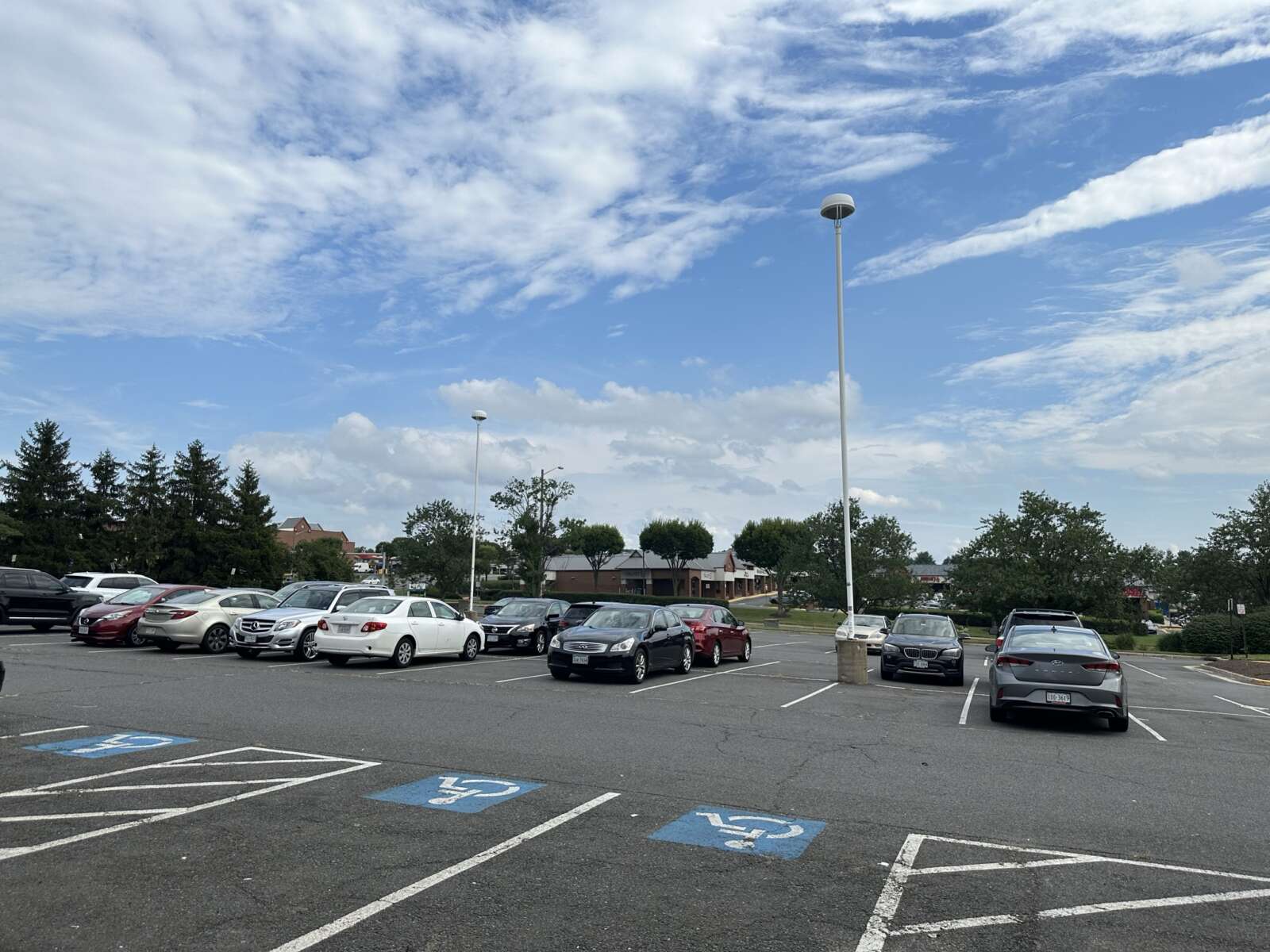
After updating its parking standards last fall, Fairfax County is conducting an online survey seeking feedback from the community on its current supply of accessible/ADA parking spaces.
The Fairfax County Board of Supervisors adopted new parking standards last September for the first time in 35 years through its Parking Reimagined initiative. Among other changes, the amendment created a tiered system for parking requirements based on a development’s density and proximity to transit.
A spokesperson with the county’s Land Development Services (LDS) says discussions about the potential impacts of the updated requirements on the supply of accessible parking prompted the board to approve a review of the standards.
“The county is analyzing whether a higher requirement to compensate for the change in baseline parking rates is appropriate and implementable,” the spokesperson told FFXnow.
Currently, accessible parking requirements are based on the overall number of spaces provided for a use, such as an apartment building, retail store or restaurant. The rates are based on federal Americans with Disabilities Act requirements as well as Virginia’s state requirements.
“Text was already added to the new requirements to preserve a stable amount of accessible parking even when general parking supply is reduced either with new parking rates or parking adjustments,” the LDS spokesperson said. “However, there was some concern that our new baseline rates would create a gap that requires less accessible parking.”
Potential changes could be broadly applied or targeted to certain circumstances. Additionally, there could be recommendations on the management of accessible spaces, such as standards for additional signage.
The online survey will be “essential in helping the department develop recommendations,” the LDS spokesperson said.
“The survey was created to get a better understanding of accessible parking experiences from those who need and use it,” they said. “From that, we can determine how we should look at potential changes to parking requirements.”
The survey is available until April 15.
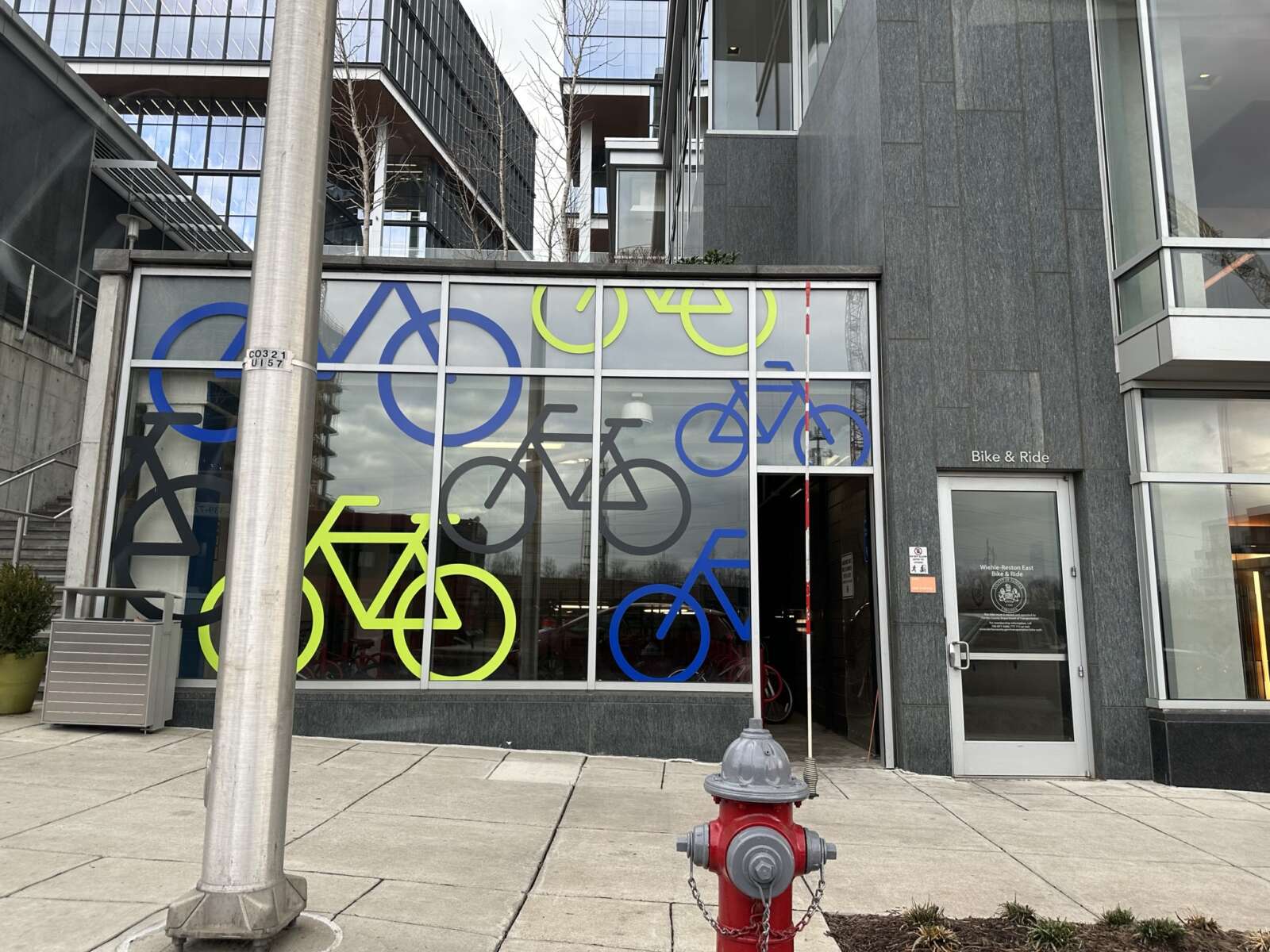
Fairfax County’s new bicycle parking standards are getting refined as part of a broad effort to ensure consistency across the county’s various transportation policies.
At a transportation committee meeting yesterday (Tuesday), the Fairfax County Board of Supervisors expressed support for an update to the bicycle parking guidelines — although the guidelines were not yet available for review.
The county got up to speed with the current age of telework and transit-oriented development by introducing bicycle parking requirements in September.
The “Parking Reimagined” initiative established how many bicycle parking spaces are required and basic rules for the design and general location of the spaces. But staff noted that the new requirements don’t align with guidelines formulated in 2014.
“It’s really great to know we’re thinking about this, that we’re tackling it. Doing this better will have great effects for the county,” said Dranesville District Supervisor Jimmy Bierman, who chairs the committee.
Additionally, the zoning ordinance doesn’t address parking ratios for visitor and long-term parking or provide detailed information about wayfinding signage, rack spacing, security needs and other amenities, county staff said in a presentation to the committee.
The guidelines currently being crafted would be divided by short-term parking for visitors and long-term parking, which is for employees, transit users, apartment residents and bicycle cages or lockers, according to Nicole Wynands, a planner for the Fairfax County Department of Transportation.
For short-term parking, the guidelines will cover location, access, markings, maintenace, rack types and spacing. Long-term parking guidance will detail similar issues, along with room layout, security recommendations, and e-charging.
Wynands noted that the guidelines will provide different ratios based on land use. FCDOT is contemplating a 90-10% split for long-term and short term parking, respectively, in residential areas and a the reverse split for long-term and short term parking respectively in retail areas.
“Retail use has a very different need,” Wyannds said.
Discussion on the proposal was limited, given that the details haven’t been officially reviewed by the board.
The county hopes to release the guidelines to the board soon so the public review process can begin in early March, followed by potential board endorsement by the summer.
Board of Supervisors Chairman Jeff McKay said that, although the guidelines were not yet available, he was supportive of the idea.
Hunter Mill District Supervisor Walter Alcorn said staff should ensure that existing bicycle guidelines for specific areas like Reston are consistent with other, similar policies.
“It seems like there needs to be some sort of normalizing across these different area guidelines,” Alcorn said.
McKay asked staff if there was some way to encourage more commercial residential properties to conform with the county’s guidelines on bicycle parking.
“I’m just wondering if we’re evaluating where we can see with our own vision today where the need for these facilities are,” he said.
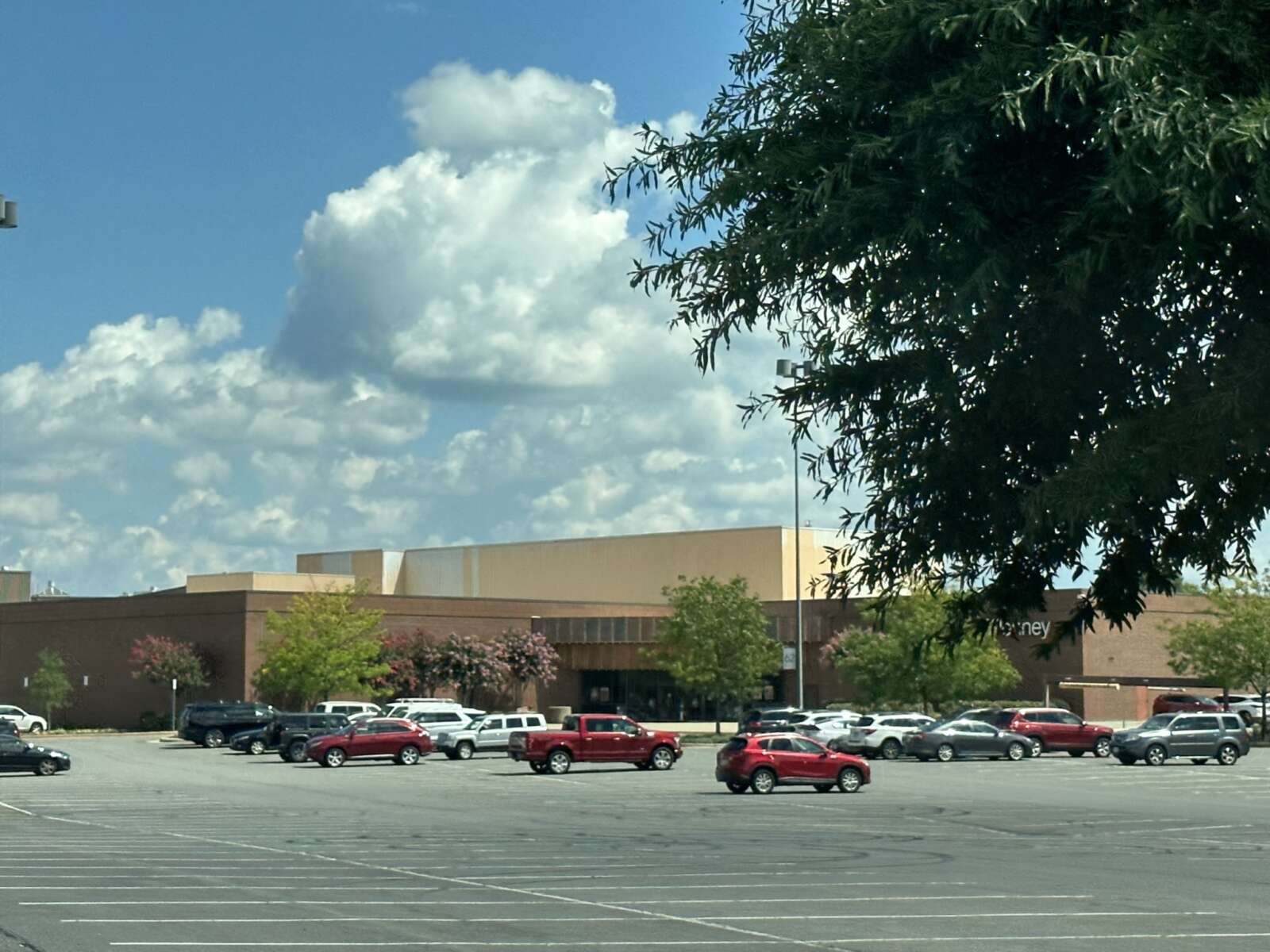
Fairfax County has officially updated its parking standards for the age of telework and transit-oriented development.
After a public hearing on Tuesday (Sept. 26) that drew dozens of speakers, the Fairfax County Board of Supervisors unanimously approved a slate of off-street parking regulations intended to steer away from the car-centric impulses that governed the suburb as it grew post-World War II.
Launched in fall 2021, the Parking Reimagined initiative was the county’s first comprehensive review of its off-street parking and loading requirements since 1988.
At that time, the Berlin Wall was still standing, the Fairfax County Government Center hadn’t been built, and the county was designed to avoid the possibility that “somebody could show up and have to circle a few minutes to find a parking spot,” Braddock District Supervisor James Walkinshaw observed.
“The county’s changed. We all know that. A diverse and urbanized county needs a variety of approaches to parking,” said Sully District Supervisor Kathy Smith, who oversaw the effort as chair of the board’s land use policy committee. “…Providing dedicated parking is still necessary in Fairfax County, but the dedicated parking must be right-sized to address current and future land use development.”
Set to take effect at 12:01 a.m. on Jan. 1, 2024, the approved amendment establishes a tiered framework that imposes different minimum parking requirements based on a development’s density and proximity to transit.
For multifamily residential developments, most of the county will fall under the base rate of 1.45 spaces per unit, as recommended by the Fairfax County Planning Commission. That’s lower than the existing rate of 1.6 spaces but higher than the 1.3 spaces that staff proposed.
Projects in more urbanized areas, including suburban centers, revitalization areas, transit station areas, transit-oriented districts, and the Planned Tysons Urban Center (PTC) District, face lower requirements.
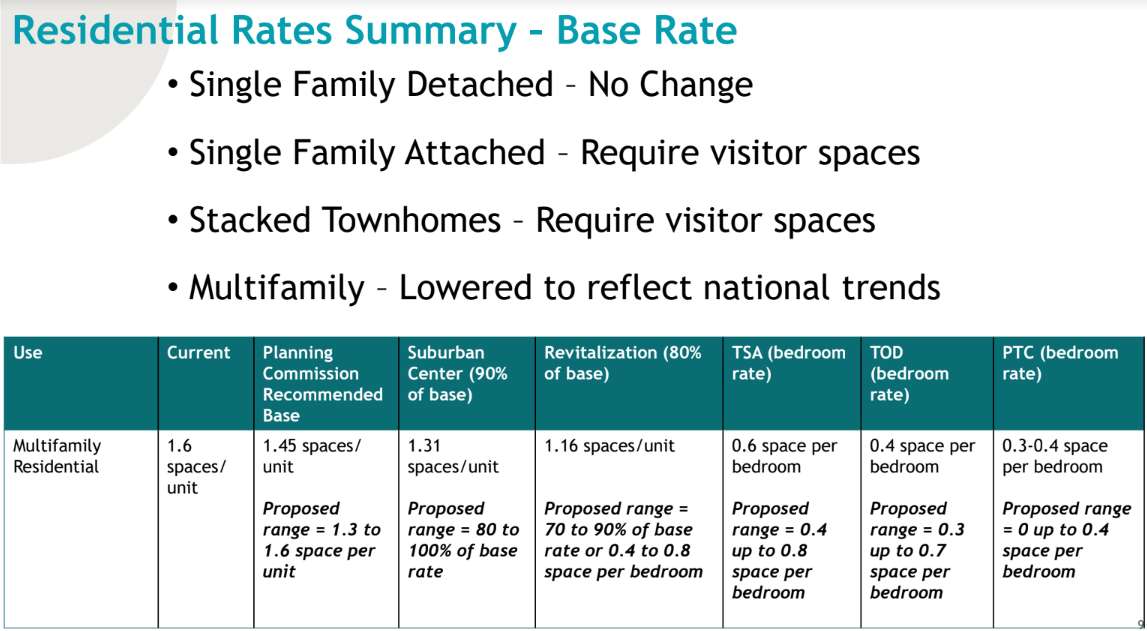
“Reducing the influence of parking in high-density areas creates opportunities to build compact developments with quality pedestrian infrastructure that allows people to travel by non-vehicular modes to access goods, services, and employment, resulting in reduced overall vehicle emissions,” county staff said.
No changes were proposed for single-family detached housing, but single-family attached and stacked townhouses will now be required to provide visitor parking in common areas, rather than confining those spaces to the driveways or garages of individual units. Read More
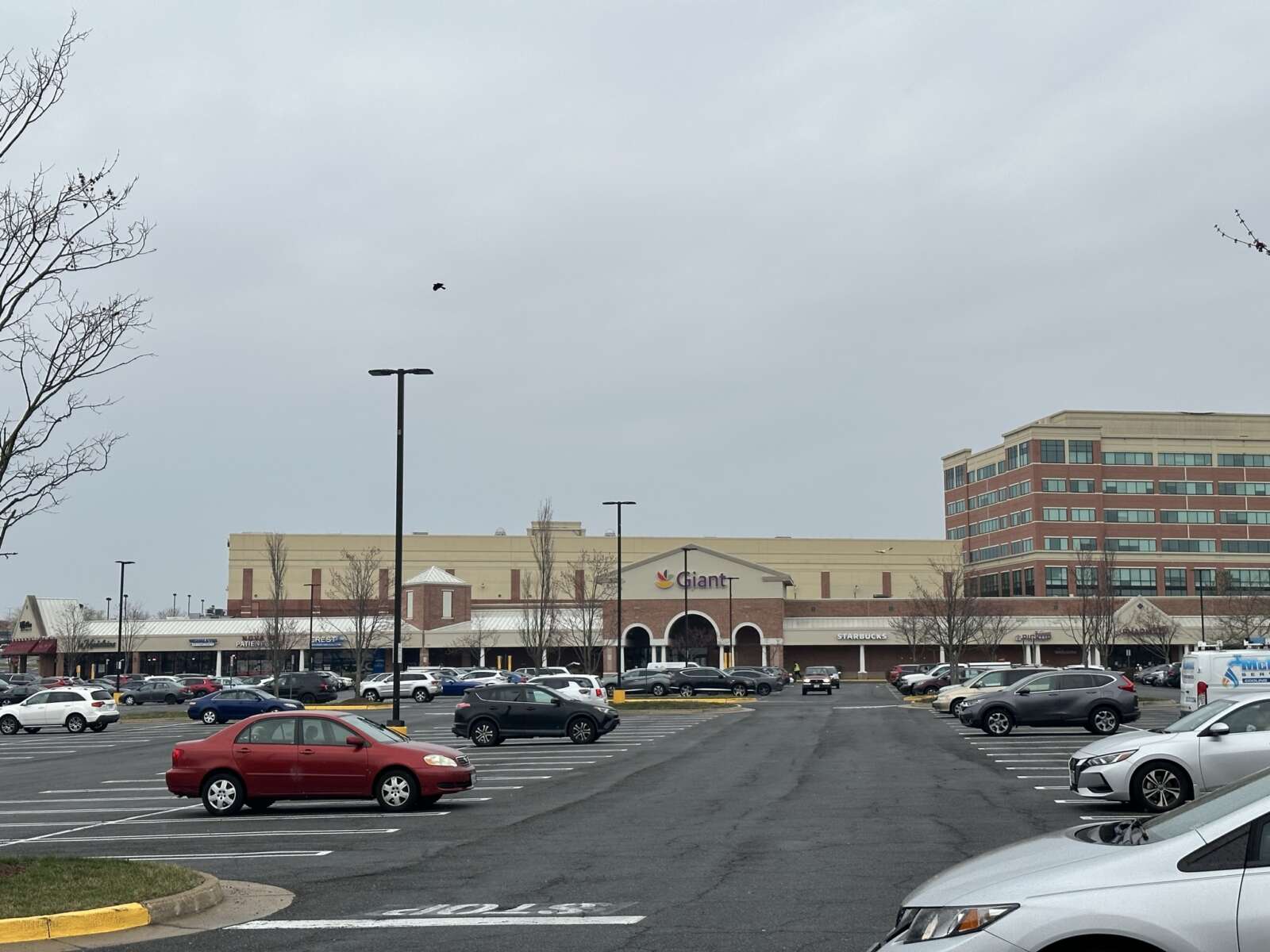
In its first public hearing last Wednesday (July 26), the Fairfax County Planning Commission heard from the community on its proposed overhaul of parking requirements.
The initiative known as Parking Reimagined puts forth changes to off-street parking, bicycle parking, and loading. Overall rates and regulations have not been comprehensively reviewed since 1988.
The county says the goal is “an evaluation of existing parking rates to determine if adjustments of requirements to meet current parking demand is appropriate, while also examining County administration of parking regulations.”
One of the most notable changes is a tiered system for off-street parking, where rates are based on a development’s gross square footage instead of the number of people served.
In a report released July 12, county staff called the system the “most critical new component” of Parking Reimagined. The proposal also allows the county to approve shared parking reductions and transit-based reductions of up to 30%.
Susan Jollie, president of the Hummer Woods Civic Association in Annandale, called the reduction in the minimum parking requirements “radical.”
“The proposed radical reductions in the minimum parking requirements will create numerous new problems while failing to secure the alleged public benefits,” Jollie said. She added that the proposal is controversial because of a failure to perform relevant research.
Dennis Hays, a representative for the Reston Citizen Association, points to the high number of residents who own a car within the county as a reason for opposition.
“The county’s website says that only 4% of U.S. households do not own a car,” Hays said. “That means 96% of household in Fairfax County have a car — 30% have more than one car possibly subject to that. So it’s not possible to simply say that everybody in this county is going to be able to ride their bike to Whole Foods, or hike out to the Blue Ridge Mountains on any given day.”
Earlier this month, the Reston Citizen Association wrote a letter of opposition to the county, saying proposal doesn’t fully consider the impact on Reston and the county.
The proposal saw some support from people who said it’s good for the county’s future.
Aaron Wilkowitz, vice president of Fairfax County’s chapter of YIMBYs of Northern Virginia, called the proposal a step in the right direction for the county.
“Parking minimums contribute to environmental destruction because parking lots themselves create heat islands retaining warmth from the sun,” Wilkowitz said. “Parking spaces increased car dependency, which leads to more smog and carbon emissions and parking spaces worsen housing scarcity.”
Sonya Breehey, Northern Virginia advocacy manager for the Coalition for Smarter Growth, said the proposal will benefit housing and climate.
“The proposed zoning amendment offers to better balance future parking demand with other communities like equity, affordability, environmental sustainability and effective land use,” she said.
Though the public hearing lasted more than four hours, the planning commission scheduled a second one for Sept. 13. After that, the matter is set to go before the Board of Supervisors on Sept. 26. If approved, the changes would go into effect on Jan 1.
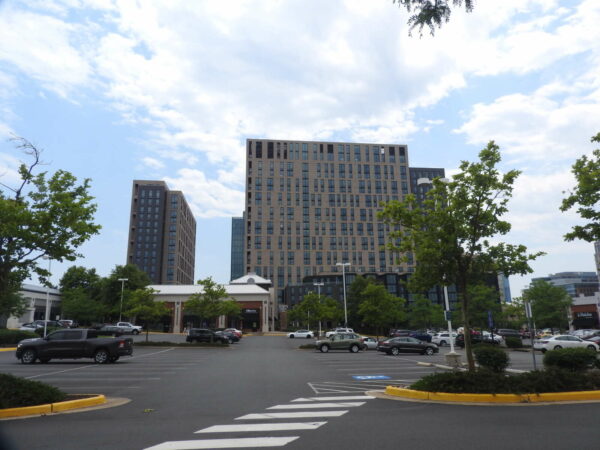
A Fairfax County proposal to overhaul parking regulations has attracted opposition from a local citizens group.
In a letter to the county, the Reston Citizens Association, a nonprofit citizen advocacy group founded in 1967, said the Parking Reimagined proposal does not fully consider the impact of the changes on Reston and the county overall.
“The RCA strongly urges that this proposal be withdrawn until at least such time as its conformity with the letter and the spirit of the One Fairfax Policy, the ADA, and other guiding principles can be achieved,” the letter states.
Specifically, two-page letter asserts that the changes will “significantly and adversely impact low-income, blue-collar workers, minorities, the elderly and disabled citizens.”
The effort kicked off in August 2021 when county staff began exploring ways to update an article of the zoning ordinance that regulates off-street parking and loading. Overall rates and regulations haven’t been comprehensively reviewed since 1988.
The initiative is intended to modernize those requirements and generally analyze parking and loading supply, demand factors, and loading trends.
On July 12, the county released a staff report on the issue ahead of Fairfax County Planning Commission hearings planned on July 26 and a Board of Supervisors hearing on Sept. 26.
“Significantly reducing unnecessary parking requirements in Metrorail station areas creates a return on the County’s investment in rail transit by aligning non-auto transportation options with transit access,” the staff report reads. “Reducing unnecessary parking supports placemaking as identified in the strategic plan and fosters a built environment where members of the community want to gather and where businesses can grow.”
If approved, the changes would go into effect on Jan 1.
The most significant change is a tiered framework that sets parking requirements based on factors like the availability and type of transit and the allowable density of development. County staff say it’s the “most critical new component” of Parking Reimagined.
Suburban centers have a proposed rate of 90% of the base parking requirement for nonresidential uses and multifamily units, while revitalization areas have a proposed rate of 80% of the base rate. Transit Station Areas and the Tysons Urban Center have a by-right rate of 70%, while transit-oriented development areas have a 60% rate. Some areas within those categories vary.
The proposal also allows the county to approve shared parking reductions and transit-based reductions of up to 30%.
In response, RCA asserts that the proposal doesn’t take into account a full range of transportation factors, including planning for future road, bus and rail routes and changes in employment and retail configurations.
RCA also calls the premise of the proposal — lower resident vehicle usage — “unrealistic” for the next 20 to 25 years, along with the minimum parking rates for multifamily units in revitalization areas, transit station areas, and transit oriented developments.
The organization also disputes the county’s rationale that reducing off-street parking will improve the environment, noting that the proposal doesn’t require developers to add green space and trees in exchange for off-street minimum parking.
The letter also flags the Reston Town Center area as not having enough access for cars, pedestrians and bicyclists.
“The RCA appreciates the significant work staff has put into this proposal and the outreach they conducted, and we stand ready to continue to work with staff to develop a proposal that will serve the citizens of Reston and Fairfax County in the years ahead,” the memo states.
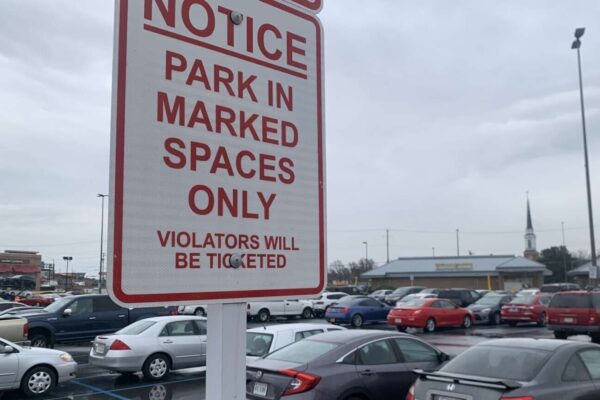
Parking requirements in Fairfax County — which are getting their first major overhaul since 1988 — are set for public hearings later this year.
The multi-year effort — coined Parking Reimagined — is the focus of an open house coming this week.
“Access to the internet, along with flexible telework options and convenient home delivery of goods, has decreased the need or desire to drive to shop or work,” the county says. “Growth of transit availability with the expansion of Metrorail and bus service and the movement toward compact walkable mixed-use communities has decreased the need for auto trips and parking demand.”
The county is now seeking feedback on draft recommendations related to off-street parking, loading and bicycle parking. A final draft is expected to be released later this year, with public hearings slated for the spring.
“County staff’s final recommendations will be presented at each of those public hearings,” the county says.
One of the most significant changes is the introduction of a tiered system for off-street parking requirements in the county’s specialized planning districts. The effort is intended to accommodate and encourage more modes of transportation in walkable and high-density areas.
Most of the county would be designated as tier 1, which covers low-density areas that would only see modest parking rate reductions. Tier three — the highest tier — would see the most significant changes.
The tiered system sets rates based on the development’s gross square footage instead of the number of people served:

The proposal reduces the parking rate for shopping centers by excluding interior open areas of centers under 1 million square feet from parking calculations.
For residential uses, apartment unit spaces would be reduced from 1.6 to 1.3 spaces per unit.
For townhouses, 2.7 spaces per unit are required, with 0.2 set aside for visitor or shared parking. That’s lower than a previous proposal of 0.7 in response to concerns about increases in impervious surfaces. A similar change is under consideration for stacked townhouses.
With regards to off-street parking, the county would round down instead of up when calculating the parking requirement. For example, if the tabulated parking is 3.7, only three spaces would be required instead of four.
Also, the number of required accessible spaces will be calculated using the overall baseline minimum for a particular building or use before taking into account any adjustments allowed for suburban centers and revitalization areas.
After holding a meeting last week, the county is set to hold another open house on Thursday (Jan. 12) at 7 p.m., followed by a discussion before the Board of Supervisors’ land use policy committee on Feb. 14 at 1:30 p.m.
Comments should be submitted by next Monday (Jan. 16) to be reviewed by staff for inclusion in the final draft.
“It continues to be important to strike a balance between the importance of parking and the environment while maintaining shared parking opportunities,” the county says.
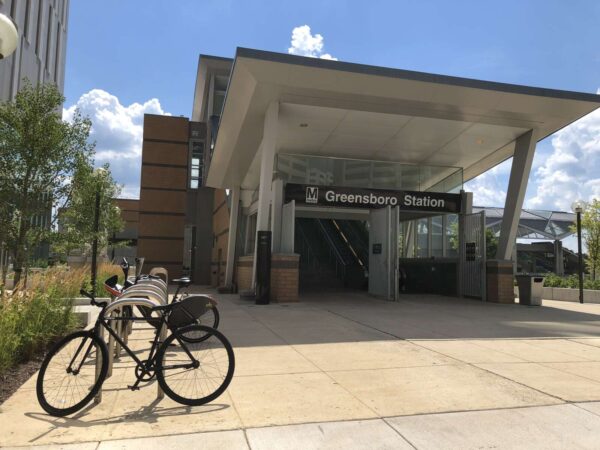
Fairfax County hopes to increase the availability of bicycle parking spaces by establishing a tiered system that sets minimum requirements for developers.
At a land use committee meeting last week, the Board of Supervisors received an update on the county’s Parking Reimagined project, a comprehensive overhaul of the county’s three-decade-old parking requirements.
One goal is to increase bicycle parking availability, potentially by setting minimum requirements for any new construction, change in use of a building, or expansion of an already-existing development. The requirement would vary based on density — essentially the inverse of the tiered system proposed for car parking, which the county hopes to reduce in high-density, transit-oriented areas.
“The minimum bicycle parking requirement increases as auto parking minimums decrease within the tiered framework, reflecting enhanced abilities to use this mode of transportation within higher density and intensity development areas,” county staff said in a white paper. “Overall, minimum bicycle parking requirements are expected to encourage more biking as the community will begin to expect these parking facilities to be [placed] at their destinations.”
At a minimum, any new construction will have to provide two bicycle parking spaces. From there, the number of required spaces will depend on the type of construction, location, and number of vehicle parking spaces.
A bicycle parking space is defined as an outdoor rack or a built storage facility.
Most developments — from apartment buildings and other multifamily dwellings to museums — would need to match 5% to 15% of the provided car parking spots. The denser an area is, the higher the percentage it will be required to meet.
For example, a community swim club located in the Tysons Urban Center would need bicycle spots equal to 15% of the number of car parking spots. If there are 20 spots for cars or other motorized vehicles, there has to be at least three spots for bicycles.
A shopping center in a suburban neighborhood along the Richmond Highway Corridor would face a 10% minimum. So, if there are 100 vehicle parking spots, there needs to be 10 available for bikes.
The potential for increased availability of parking in the county has been met with strong support from local bicycling advocates.
The Fairfax Alliance for Better Bicycling has followed the Parking Reimagined initiative closely since it launched last year and has advocated for bicycle parking requirements from the beginning. While not perfect, FABB President Bruce Wright believes “they are a start.”
“Creating more space for secure bike parking encourages greener transportation, frees up land for housing or green space, and most importantly, is more equitable,” Wright said in a statement to FFXnow. “Requiring bike parking in the zoning ordinance is a major accomplishment.”
However, he said the requirements remain “insufficient” and believe that demand, especially in multifamily dwellings, will far outweigh supply if developers only meet the proposed minimum.
More public hearings and engagement opportunities on the plan will be scheduled for the remainder of this year and into early January.
County staff plan to bring a final Parking Reimagined draft plan incorporating public feedback back to the Board of Supervisors sometime in early 2023.
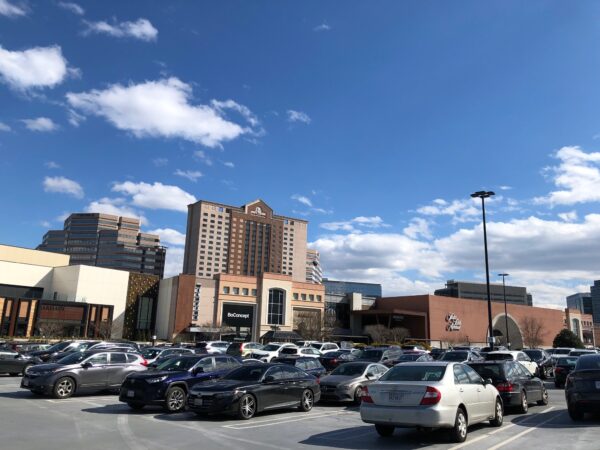
As part of an ongoing review of off-street parking rules, Fairfax County is considering an overhaul of its parking requirements for new development.
Under the proposed tiered system, the number of parking spaces required for a particular development would vary depending on the density of the surrounding area.
Currently, developers must provide a certain amount of parking based on the type of use and how many people their building will serve. The same standards are applied throughout the county, though a special planned district for Tysons has its own rules.
The new system would leave standards for low-density areas largely unchanged, but it would impose a ceiling on the amount of parking allowed in medium-density areas and significantly limit parking in high-density, transit-oriented developments.
Those developments need less parking, because they are designed to be walkable and accessible by transit, so people can get to work, shop, and engage in other activities without having to get into a car, the county’s land-use and planning staff argues.
However, with Metro still reeling from last year’s train derailment and Fairfax County’s efforts to build more pedestrian and bicycle-friendly infrastructure a work in progress, transportation experts say signs point to people driving more frequently than they did before the pandemic as more workers return to offices.
According to The Washington Post, experts attribute the shift toward driving over mass transit to the rise in remote and hybrid work. Commuters might be more willing to drive now — and put up with increasing rush-hour congestion — when they only have to make that trip a couple of times a week.
Do you think having less parking in more developed, transit-oriented areas will help reduce Fairfax County’s reliance on cars, or will it just inconvenience people without producing the desired changes in behavior?

As part of the first comprehensive overhaul since 1988, Fairfax County officials are proposing a tiered system for parking requirements based on development density.
The effort, dubbed Parking Reimagined, kickstarted in response to changing patterns of behavior, technology demographics, and 34 years of development, particularly bus service and Metrorail.
At a Land Use and Policy Committee meeting yesterday (Tuesday), the Fairfax County Board of Supervisors concurred that a tiered system would be an appropriate approach to modernize how the county regulates parking and determines requirements for development.
Board Chairman Jeff McKay lauded staff for not pursuing a “one-size fits-all approach.”
In tier 1, which covers most of the county, low density areas would see only minor changes and modest parking rate reductions. Medium density areas — which are not located in transit areas — would be subject to maximum parking requirements.
But in tier three — high-density areas with urban, mixed-use, and multimodal-oriented development — parking requirements would be significantly reduced to discourage the use of cars and encourage walkability and pedestrian-oriented development.
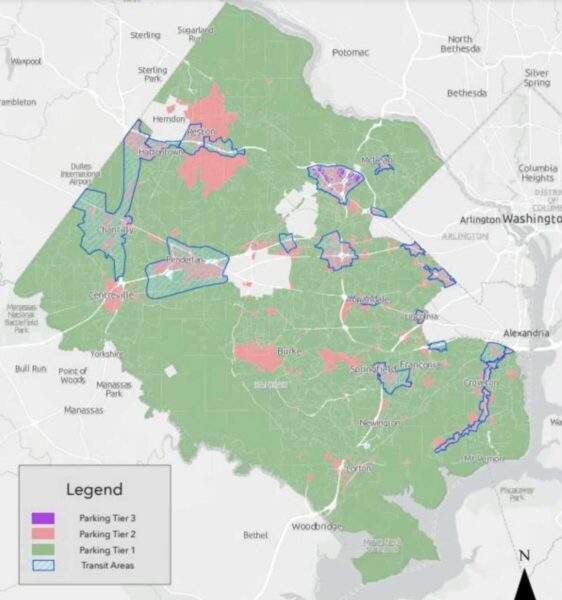
The county kicked off a month-long series of town halls in November, courting pubic feedback on its first comprehensive parking review in decades.
Public hearings are slated to begin in the fall following community engagement on the draft proposal this summer.
“It is recognized that driving a car will continue to be common activity and that parking will continue to be necessary,” a March county memo says. “However, parking should be considered with other community and personal values.”
Parking requirements can be further reduced in Transit Station Areas and Commercial Revitalization Districts, including the Tysons Urban Center, community business centers, and suburban centers like Dulles, Fairfax Center, and Merrifield.
For example, current requirements state that developments must provide one space for every three people served, along with an additional space per employee.
The new system would set rates based on the tiered system and calculate parking based on the structure’s square footage instead of the number of people served:

The county is also contemplating adding other components to its parking regulations, including bicycle parking, parking lot landscaping, off-street loading, and electric vehicle charging.
Parking Reimagined could set a minimum required number of spaces for electric vehicles. Last year, the county allowed parking spaces for EVs to be used in calculations for total parking requirements.
The overhaul could also establish minimum bicycle parking requirements in order to encourage the use of bicycles in specific areas of the county.
“Not every transit center is the same as the one in Tysons,” said Providence District Supervisor Dalia Palchik.
The county hired consultant Clarion-Nelson/Nygaard to review nine regional and national municipalities to assess best practices used in other communities. That framework was used to guide the county’s effort.
Hunter Mill District Supervisor Walter Alcorn encouraged the county’s planning and development staff to coordinate changes to off-street parking requirements with other departments. He also suggested that the county consider ways to open up private parking to the public.
“We do have communities in the county that do not have parking shortages and parking challenges,” Alcorn said.
Dranesville District Supervisor John Foust suggested establishing a parking authority to enforce parking-related issues and regulations in areas like Tysons.
“I think it’s something we should absolutely be looking at even if its just to come back and say it’s not going to work,” Foust said.

If you’ve ever lost precious minutes circling a parking lot for an available spot or questioned the amount of space devoted to parking in a new development, the time to voice those concerns has come.
Fairfax County kicked off a month-long series of town halls last week for the public to weigh in on its first comprehensive parking review in decades, inviting stakeholders from business interests and nonprofits to tenants and religious groups to provide feedback.
Any recommended changes are expected to go to the Planning Commission and Board of Supervisors for votes in late 2022.
“We have lots and lots of privately owned parking, and sometimes it seems we have more than enough parking, and sometimes, we don’t have enough,” Hunter Mill District Supervisor Walter Alcorn said during an online town hall meeting on Nov. 10.
Dubbed Parking Reimagined, the county’s initiative focuses on off-street parking. It began last month and could run for 12-18 months. County rules regulate current parking as well as what future developments must build, though exceptions can be made.
The county is partnering with a consultant team, Clarion-Nelson\Nygaard, to study the matter, but a principal with Nelson\Nygaard, Iain Banks, noted that they’re looking at data from 2019 and earlier due to the pandemic’s effects on remote work, the use of transit, and other factors.
“Transportation is changing rapidly, not only as a result of COVID and the subsequent recovery from COVID but also into a future where perhaps traffic peak periods are going to change throughout the day,” Banks said. “It’s not going to be that typical morning and evening rush hour perhaps; it’s going to be more spread out throughout the day as flexible schedules perhaps become the norm.”
Residents expressed the need for parking and observed that parking costs money in the form of taxes, a parking permit, or a parking meter, though Fairfax County currently doesn’t operate any meters for off-street parking.
Michael Davis, parking program manager with the county’s Land Development Services department, said at the town hall last week that the initiative could help people think of parking as a resource.
He said they’re looking at “right sizing” parking, where the supply is appropriate for the demand. He noted that times of high and low demand can change by the hour and season, and there can even be times when cars are unnecessary, such as for nearby commutes.
Davis also raised the idea of shared parking. Instead of requiring a minimum number of parking spots, such as for a site with apartments, offices, and retail, a smaller parking area can be built that provides enough parking for all based on hourly demand.
County officials emphasized their interest in hearing from people at the town hall, which also turned into a brainstorming session of sorts.
Alcorn wondered if there was a way to track the progress of parking availability at developments. Davis noted that technology is already at Reston Town Center and Tysons Corner Center, which have electronic signs in their garages that show how many parking spots are available in real time.
But the changes in behaviors driven by the pandemic are leading officials to cautiously approach how to gather current data.
Information about upcoming meetings and other updates can be found on the county’s website for the project.

